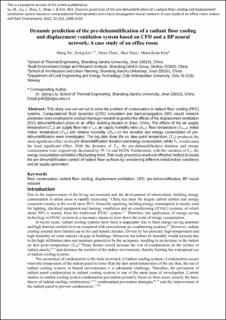Dynamic prediction of the pre-dehumidification of a radiant floor cooling and displacement ventilation system based on computational fluid dynamics and a back-propagation neural network: A case study of an office room
Peer reviewed, Journal article
Accepted version

View/
Date
2022Metadata
Show full item recordCollections
Abstract
This study was carried out to solve the problem of condensation in radiant floor cooling systems. Computational fluid dynamics simulation and back-propagation neural network prediction were employed to conduct thorough research to predict the effects of the displacement ventilation dehumidification phase in an office building located in Jinan, China. The effects of the air supply temperature (Tas), air supply flow rate (Vas), air supply humidity ratio (Has), floor temperature (Tfloor), initial indoor temperature (Tini) and relative humidity (Hini) on the duration and energy consumption of pre-dehumidification were investigated. The big data show the air dew point temperature (Tad) produced the most significant effect on the pre-dehumidification duration and energy consumption, while Tas would cause the least significant effect. With the decrease of Tad, the pre-dehumidification duration and energy consumption were, respectively, decreased by 59.1% and 44.2%. Furthermore, with the variation of Vas, the energy consumption exhibited a fluctuating trend. This study provides a novel and effective method to assess the pre-dehumidification control of radiant floor surfaces by considering different initial indoor conditions and air supply parameters.